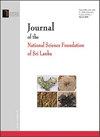紫竹体外创面愈合潜力的研究米勒
IF 0.4
4区 综合性期刊
Q4 MULTIDISCIPLINARY SCIENCES
Journal of the National Science Foundation of Sri Lanka
Pub Date : 2023-06-30
DOI:10.4038/jnsfsr.v51i2.11232
引用次数: 0
摘要
无法愈合的伤口是一个全球性的健康问题。增强细胞增殖、血管生成和预防细菌感染的物质可以加速伤口愈合过程。在本研究中,研究了泽泻的伤口愈合潜力,包括其细胞增殖、血管生成和抗菌潜力。分别使用Madin-Darby Canine Kidney(MDCK)细胞和鸡绒毛尿囊膜(CAM)测定法,通过划痕试验(SWA)评估了酿酒酵母叶片和树皮的己烷、二氯甲烷、乙酸乙酯和甲醇提取物的细胞增殖增强潜力(平均伤口闭合百分比)和血管生成反应(平均血管指数)。采用纸片扩散法评价了这些提取物对枯草芽孢杆菌、金黄色葡萄球菌、大肠杆菌和铜绿假单胞菌的抗菌活性。叶片的己烷、二氯甲烷和乙酸乙酯提取物以及树皮的己烷提取物显示细胞增殖增强。叶片的甲醇和乙酸乙酯提取物以及树皮的甲醇和己烷提取物显示出增强的血管生成反应。叶和树皮的二氯甲烷提取物对铜绿假单胞菌都表现出相当大的抗菌活性,而铜绿假单胞杆菌对常见抗生素不太敏感。SWA直接分离叶片的己烷提取物,分离和鉴定出一种活性组分,其平均伤口闭合率为86.4%(阳性对照90.2%),平均血管指数为34.5(阳性对照48.6)。该组分含有羽扇豆醇、α-淀粉、β-淀粉、二十六烷醇和二十八烷醇。本研究为啤酒花叶和树皮提取物增强伤口愈合的潜力提供了支持性证据。本文章由计算机程序翻译,如有差异,请以英文原文为准。
In-vitro wound healing potential of Ziziphus oenoplia (L.) Miller
Non-healing wounds are a global health problem. Substances that enhance cell proliferation, angiogenesis, and prevention of bacterial infections accelerate the wound healing process. In this study, the wound healing potential of Ziziphus oenoplia, is investigated for its ability in cell proliferation, angiogenesis, and antibacterial potential. The potential of cell proliferation enhancement (mean percent wound closure) and angiogenic response (mean vascular index) of hexanes, dichloromethane, ethyl acetate, and methanol extracts of leaf and bark of Z. oenoplia were evaluated by scratch wound assay (SWA) using Madin-Darby Canine Kidney (MDCK) cells and chick chorioallantoic membrane (CAM) assay, respectively. The antibacterial activity of these extracts was evaluated against Bacillus subtilis, Staphylococcus aureus, Escherichia coli, and Pseudomonas aeruginosa by disc diffusion method. Enhanced cell proliferation was shown by the hexanes, dichloromethane, and ethyl acetate extracts of leaf and the hexanes extract of bark. An enhanced angiogenic response was shown by the methanol and ethyl acetate extracts of leaves and the methanol and hexanes extracts of bark. Dichloromethane extract of both leaf and bark showed considerable antibacterial activity against P. aeruginosa which is less susceptible to common antibiotics. SWA-directed fractionation of the hexanes extract of the leaf has resulted in the isolation and identification of an active fraction showing mean percent wound closure of 86.4% (positive control 90.2%) and mean vascular index of 34.5 (positive control 48.6). This fraction contained lupeol, α-amyrin, β-amyrin, hexacosanol, and octacosanol. The present study provides supportive evidence for the potential of wound healing enhancement of leaf and bark extracts of Z. oenoplia.
求助全文
通过发布文献求助,成功后即可免费获取论文全文。
去求助
来源期刊

Journal of the National Science Foundation of Sri Lanka
MULTIDISCIPLINARY SCIENCES-
CiteScore
0.90
自引率
0.00%
发文量
57
审稿时长
>12 weeks
期刊介绍:
The Journal of National Science Foundation of Sri Lanka (JNSF) publishes the results of research in Science and Technology. The journal is released four times a year, in March, June, September and December. This journal contains Research Articles, Reviews, Research Communications and Correspondences.
Manuscripts submitted to the journal are accepted on the understanding that they will be reviewed prior to acceptance and that they have not been submitted for publication elsewhere.
 求助内容:
求助内容: 应助结果提醒方式:
应助结果提醒方式:


